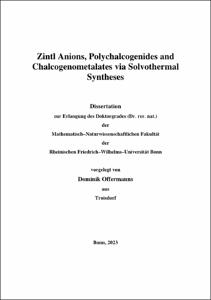Offermanns, Dominik: Zintl Anions, Polychalcogenides and Chalcogenometalates via Solvothermal Syntheses. - Bonn, 2024. - Dissertation, Rheinische Friedrich-Wilhelms-Universität Bonn.
Online-Ausgabe in bonndoc: https://nbn-resolving.org/urn:nbn:de:hbz:5-75011
Online-Ausgabe in bonndoc: https://nbn-resolving.org/urn:nbn:de:hbz:5-75011
@phdthesis{handle:20.500.11811/11372,
urn: https://nbn-resolving.org/urn:nbn:de:hbz:5-75011,
author = {{Dominik Offermanns}},
title = {Zintl Anions, Polychalcogenides and Chalcogenometalates via Solvothermal Syntheses},
school = {Rheinische Friedrich-Wilhelms-Universität Bonn},
year = 2024,
month = feb,
note = {The focus of this work is on the synthesis and structural investigation of polychalcogenides and Zintl phases. Therefore, mainly ammonothermal syntheses under mild or supercritical conditions were used. Additionally, some experiments in ethylene diamine as solvent were performed. A prerequisite for this work is the solubility if the alkaline earth metals and the lanthanides Eu and Yb in liquid ammonia due to the formation of blue electride solutions similar as it is known for the dissolution of alkaline metals. Beside binary compounds with anions containing only chalcogen atoms, it was successfully tried to link the polychalcogenides via arsenic or coinage metals to ternary compounds with more complex anionic structures or higher dimensional polyanions. Structural motifs of binary compounds in this work reach from simple anions such as (Se2)2- dumbbells in [Eu(NH3)8]2(Se2)2(Se3) to very complex anions as (Te20)8- in [Yb(NH)8]4(Te20)(Te3)·2NH3.
Reactions of lanthanindes with sulfur in liquid ammonia led to the formation of [Ln(NH3)9]2(S5)3·2NH3 (Ln = Eu or Sm), [Er(NH3)8]2(S5)2(S6)·3NH3 and [Yb(NH3)8]2(S5)2(S4)·4NH3 with slightly different chain lengths among the polysulfides. It was possible to synthesize the compounds [Eu(NH3)8][Cu(S4)2]·NH3 and [Er(NH3)8][Cu(S4)2]·NH3, containing molecular thiometallates by insertion of copper to the reaction of Eu or Er with sulfur in liquid ammonia. Analog to the thiocuprates, the selenoargentate [Ag(Se4)2]3+ in [Eu(NH3)9][Ag(Se4)2]·NH3 could be obtained.
The fact that gold is soluble in electride solutions made it possible to synthesize the four chalcogenidoaurates(III) [Yb(NH3)8](AuSe5S7)·NH3, [Yb(NH3)8](AuS4Se6), [Ca(en)4](AuTe5)2 and [Yb(NH3)8](AuSe4)3. The dimensionality of the complex chalcogenidoaurate(III) anions reaches from one- to three-dimensional. The [Yb(NH3)8]3+ complex in [Yb(NH3)8](AuSe4)3 shows an almost perfect cubic coordination, which has been mentioned so far only once in literature for the uranium(IV) complex [U(SCN)8]4-.
The molecular chalcogenidoarsenate(III) anions containing compounds [Ca(en)4]2(As4Te6), [Sr(en)4]2(As4Te6), [Eu(en)4]2(As4Se6), [Ca(en)4](As2Se6) and [Ca(en)4]2(As2Se7O) could be isolated from ethylene diamine. Their structures can all be derived from the simple salt structure types of Li2O or CsCl, respectively. The one-dimensional infinite selenidoarsenate(III) anion ∞1[AsSe2]-, in [M(en)3(H2O)2](As2Se4) with M = Ca or Sr, was isolated from ethylene diamine likewise. It shows a new conformation as zwölfer chain with very short As-Se and Se-Se interactions leading to a plausible description of an almost linear selenium chain with attached As-Se dumbbells.},
url = {https://hdl.handle.net/20.500.11811/11372}
}
urn: https://nbn-resolving.org/urn:nbn:de:hbz:5-75011,
author = {{Dominik Offermanns}},
title = {Zintl Anions, Polychalcogenides and Chalcogenometalates via Solvothermal Syntheses},
school = {Rheinische Friedrich-Wilhelms-Universität Bonn},
year = 2024,
month = feb,
note = {The focus of this work is on the synthesis and structural investigation of polychalcogenides and Zintl phases. Therefore, mainly ammonothermal syntheses under mild or supercritical conditions were used. Additionally, some experiments in ethylene diamine as solvent were performed. A prerequisite for this work is the solubility if the alkaline earth metals and the lanthanides Eu and Yb in liquid ammonia due to the formation of blue electride solutions similar as it is known for the dissolution of alkaline metals. Beside binary compounds with anions containing only chalcogen atoms, it was successfully tried to link the polychalcogenides via arsenic or coinage metals to ternary compounds with more complex anionic structures or higher dimensional polyanions. Structural motifs of binary compounds in this work reach from simple anions such as (Se2)2- dumbbells in [Eu(NH3)8]2(Se2)2(Se3) to very complex anions as (Te20)8- in [Yb(NH)8]4(Te20)(Te3)·2NH3.
Reactions of lanthanindes with sulfur in liquid ammonia led to the formation of [Ln(NH3)9]2(S5)3·2NH3 (Ln = Eu or Sm), [Er(NH3)8]2(S5)2(S6)·3NH3 and [Yb(NH3)8]2(S5)2(S4)·4NH3 with slightly different chain lengths among the polysulfides. It was possible to synthesize the compounds [Eu(NH3)8][Cu(S4)2]·NH3 and [Er(NH3)8][Cu(S4)2]·NH3, containing molecular thiometallates by insertion of copper to the reaction of Eu or Er with sulfur in liquid ammonia. Analog to the thiocuprates, the selenoargentate [Ag(Se4)2]3+ in [Eu(NH3)9][Ag(Se4)2]·NH3 could be obtained.
The fact that gold is soluble in electride solutions made it possible to synthesize the four chalcogenidoaurates(III) [Yb(NH3)8](AuSe5S7)·NH3, [Yb(NH3)8](AuS4Se6), [Ca(en)4](AuTe5)2 and [Yb(NH3)8](AuSe4)3. The dimensionality of the complex chalcogenidoaurate(III) anions reaches from one- to three-dimensional. The [Yb(NH3)8]3+ complex in [Yb(NH3)8](AuSe4)3 shows an almost perfect cubic coordination, which has been mentioned so far only once in literature for the uranium(IV) complex [U(SCN)8]4-.
The molecular chalcogenidoarsenate(III) anions containing compounds [Ca(en)4]2(As4Te6), [Sr(en)4]2(As4Te6), [Eu(en)4]2(As4Se6), [Ca(en)4](As2Se6) and [Ca(en)4]2(As2Se7O) could be isolated from ethylene diamine. Their structures can all be derived from the simple salt structure types of Li2O or CsCl, respectively. The one-dimensional infinite selenidoarsenate(III) anion ∞1[AsSe2]-, in [M(en)3(H2O)2](As2Se4) with M = Ca or Sr, was isolated from ethylene diamine likewise. It shows a new conformation as zwölfer chain with very short As-Se and Se-Se interactions leading to a plausible description of an almost linear selenium chain with attached As-Se dumbbells.},
url = {https://hdl.handle.net/20.500.11811/11372}
}






